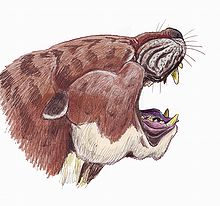Primal predators
| Primal predators | ||||||||||||||
|---|---|---|---|---|---|---|---|---|---|---|---|---|---|---|
|
Obsolete systematic group The taxon dealt with here is not part of the systematics presented in the German-language Wikipedia. More information can be found in the article text. |
||||||||||||||

Living reconstruction of Hyaenodon (painting by Heinrich Harder , created around 1920) |
||||||||||||||
| Temporal occurrence | ||||||||||||||
| Early Paleocene to Middle Miocene | ||||||||||||||
| 66 to 11.62 million years | ||||||||||||||
| Locations | ||||||||||||||
| Systematics | ||||||||||||||
|
||||||||||||||
| Scientific name | ||||||||||||||
| Creodonta | ||||||||||||||
| Cope , 1877 | ||||||||||||||
Primal predators , mock predators or Creodonts (Creodonta) are a taxon that is no longer valid today and originally referred to a group of extinct carnivorous mammals . The taxon was described by Edward Drinker Cope in 1877 , and more than 45 genera had been described well into the 20th century. The Creodonta were considered to be the predominant predatory mammals in the Palaeogene . Although they resembled today's dogs , cats , bears , hyenas, or mongooses , they are not closely related to today's predators (Carnivora). Within the Creodonta a distinction was made between two families, the dog- or hyena-like Hyaenodontidae, the best-known representative of which was the Hyaenodon , and the more cat-like Oxyaenidae . A distinctive feature of the Creodonta consisted of the breaking scissors , which sat further back in the mouth (Hyaenodontidae: between the second molar in the upper and the third molar in the lower jaw; Oxyaenidae: between the first molar in the upper and the second molar in the lower jaw) than in today's predators (fourth premolar in the upper jaw; first molar in the lower jaw).
The Creodonta lived in Europe , Asia , North America and Africa . In Eurasia and North America all Creodonts died out at the end of the Oligocene , only in Africa some genera were able to persist into the Miocene . However, the genus Hyainailouros succeeded in repopulating in the Miocene from Africa from Eurasia and here also delayed the extinction of the Creodonts a little. In the later Miocene, however, all Creodonts had also disappeared in the ancient world.
As early as the 1970s, Leigh Van Valen doubted that the Creodonta would form a common group. The doubts were later taken up by some paleontologists such as Michael Morlo from the Senckenberg Research Institute or the Belgian researcher Floréal Solé. Accordingly, there are no clear synapomorphies - common, newly acquired characteristics - between the two families of the Hyaenodontidae and Oxyaenidae, whereby a taxon Creodonta, as accepted in the list by McKenna and Bell 1997, would not exist; the term is mostly used out of habit. In the case of the common features between the Carnivora and the two Creodonta families, for example in the formation of the crushing scissors or characteristics at the base of the skull or in the structure of the foot, it is unclear whether these are synapomorphic or possibly also just convergently acquired properties. Solé therefore proposed in 2013 that the two Creodonta families each be raised to a level of order . Because of this, three lines of development can be distinguished within the Carnivora-like higher mammals (excluding the Mesonychia as ungulate -like group): the Carnivoramorpha (including the Carnivora and the extinct Viverravidae and Miacidae) as well as the Hyaenodonta (also Hyaenodontida) and the Oxyaenodonta (also Oxyaenida). Sometimes another group was accepted with the Proviverroidea, for which a closer relationship with the Cimolesta was up for discussion. In the following period, the Creodonta was divided into the following two orders according to Solé 2013:
- Oxyaenodonta Van Valen , 1971
- Hyaenodonta Van Valen , 1967
Web links
literature
- David McDonald: With teeth and claws. Life and Survival of Predators. vgs, Cologne 1995, ISBN 3-8025-1291-X .
Individual evidence
- ↑ Günter Krumbiegel, Ludwig Rüffle and Hartmut Haubold: The Eocene Geiseltal: a Central European brown coal deposit and its flora and fauna. Ziemsen, Wittenberg 1983, pp. 1–227 (p. 169)
- ↑ Jordi Augusti: Mammoths, Sabertooths and Hominids 65 Million Years of Mammalian Evolution in Europe , Columbia University Press, 2002. ISBN 0-231-11640-3
- ^ Leigh Van Valen: Adaptive Zones and the Orders of Mammals. Evolution 25 (2), 1971, pp. 420-428
- ↑ Malcolm C. McKenna and Susan K. Bell: Classification of mammals above the species level. New York (Columbia Univ. Press), 1997, 631 pp. ISBN 978-0-231-11013-6
- ↑ Floréal Solé: New proviverrine genus from the Early Eocene of Europe and the first phylogeny of Late Paleocene-Middle Eocene hyaenodontidans (Mammalia). Journal of Systematic Paleontology 11, 2013, pp. 375-398
- ↑ Michael Morlo, Gregg Gunnell and P. David Polly: What, if not nothing, is a creodont? Phylogeny and classification of Hyaenodontida and other former creodonts. Journal of Vertebrate Paleontology 29 (3 suppl), 2009, p. 152A.
- ↑ Floréal Solé and Thierry Smith: Dispersals of placental carnivorous mammals (Carnivoramorpha, Oxyaenodonta & Hyaenodontida) near the Paleocene-Eocene boundary: a climatic and almost worldwide story. Geologica Belgica 16 (4), 2013, pp. 254-261.
